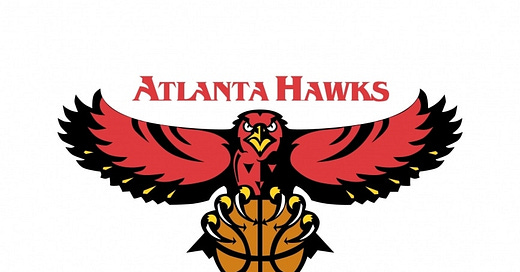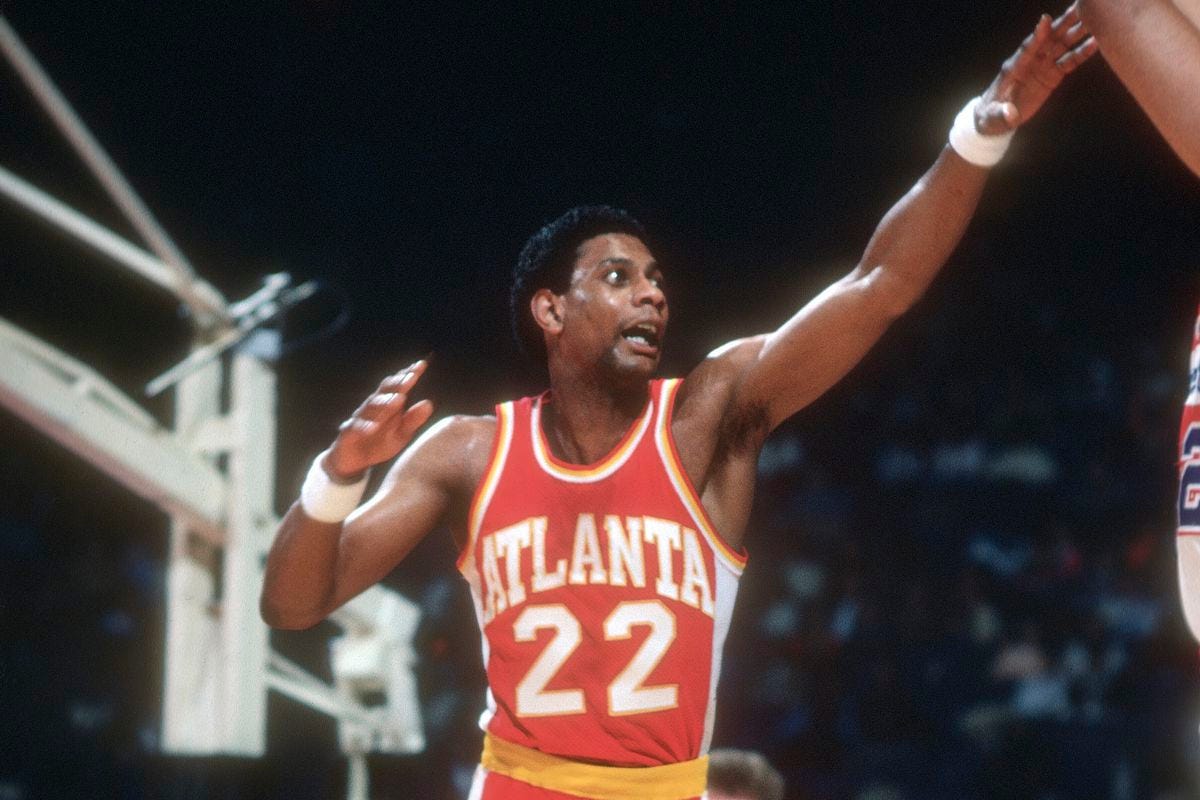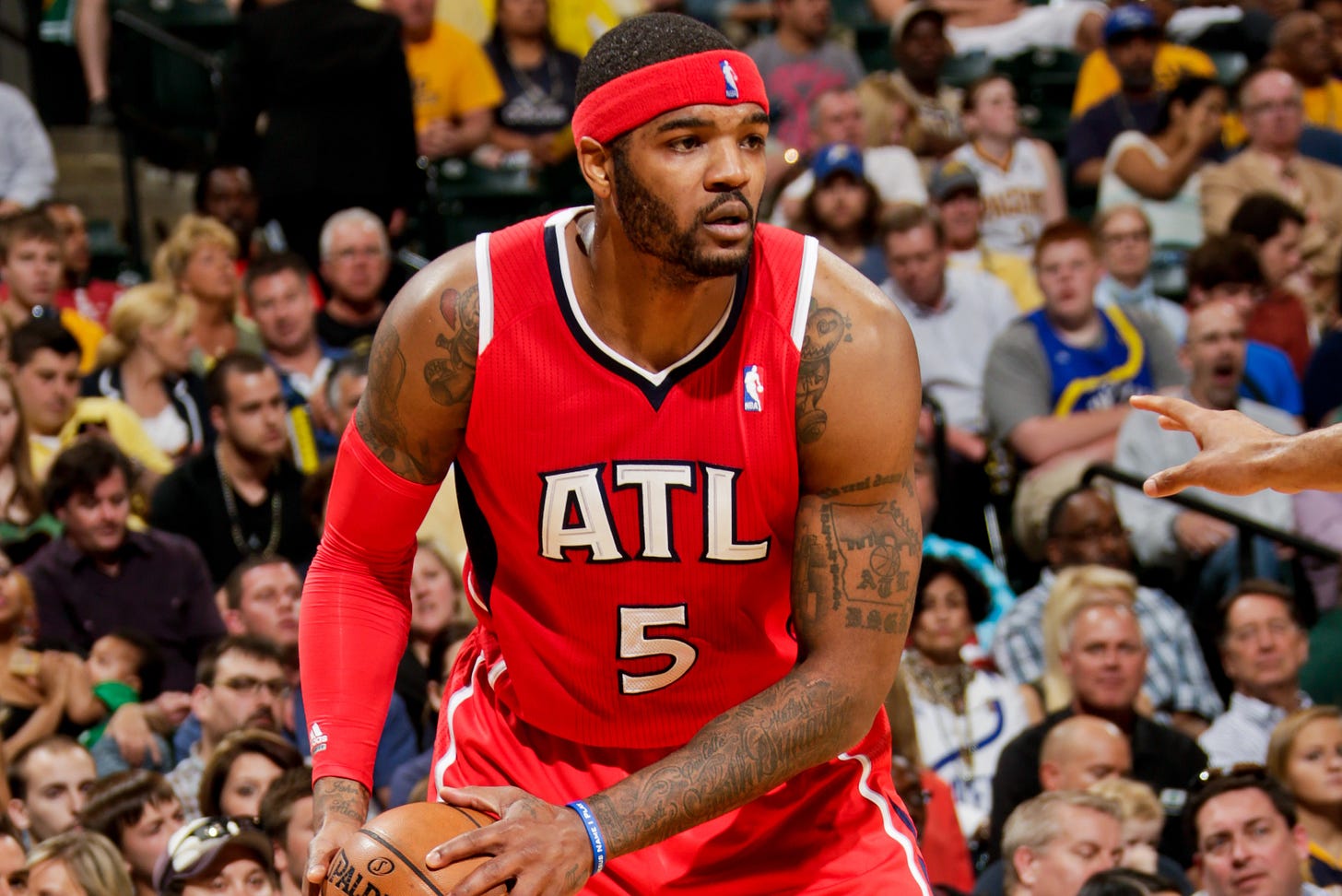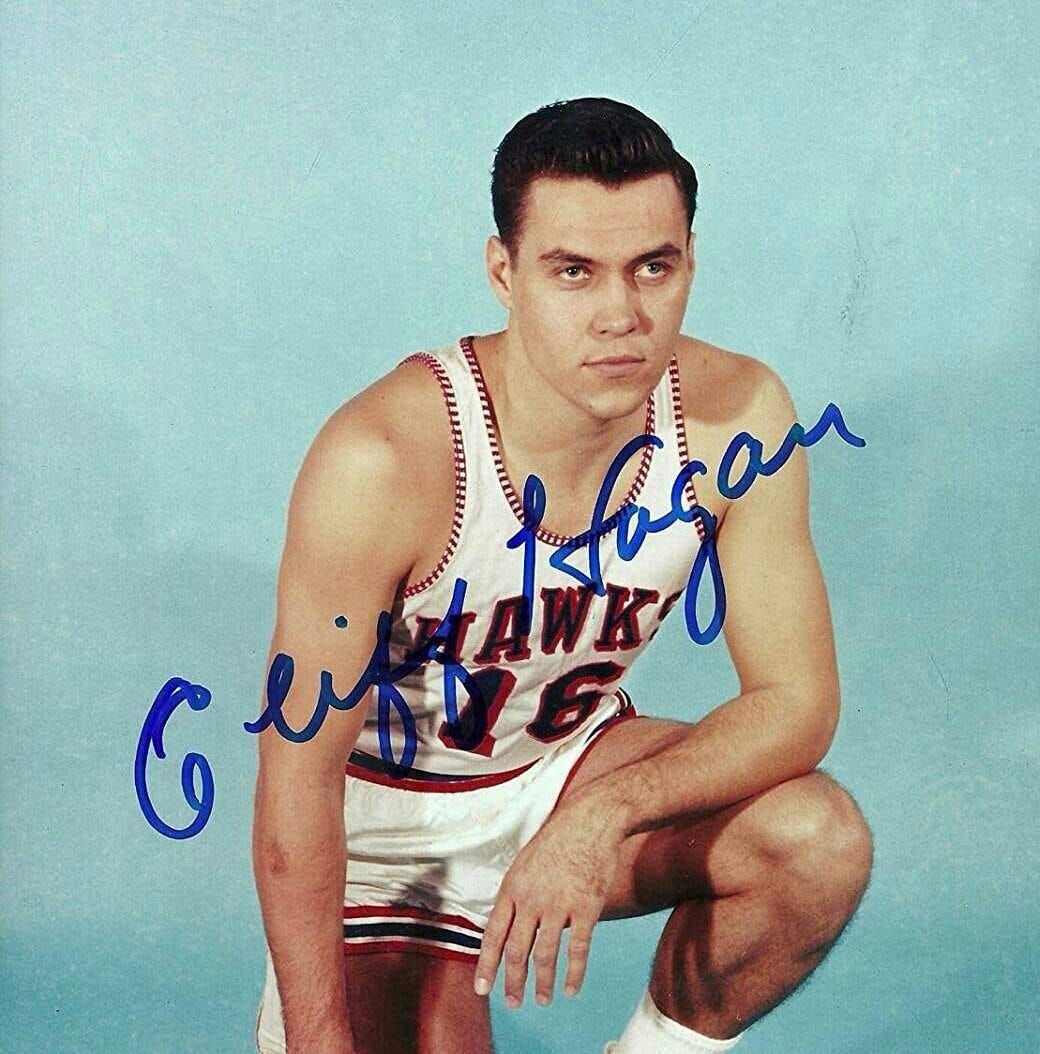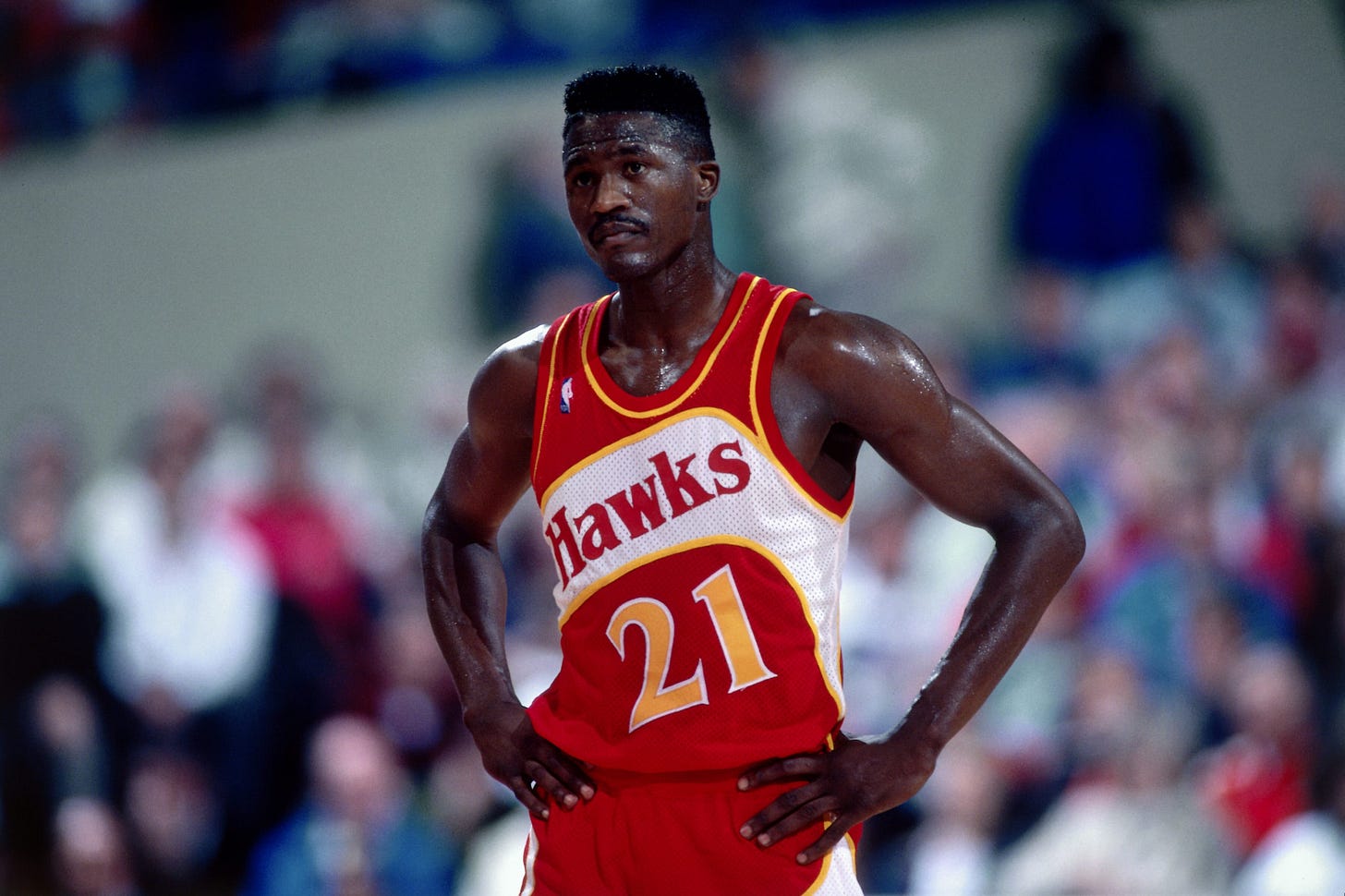Top 5 Forwards In Atlanta Hawks History
Dominique Wilkins tops the list of greatest Atlanta Hawks forwards
The Atlanta Hawks have always been a team known for their acquistions of great forwards. Some notable forwards who threw on a Hawks jersey included Kevin Willis, Paul Millsap, and Shareef Abdur-Rahim.
John Drew
Before all the drug issues and becoming the first player in NBA history to be banned from the league, John Drew was a legit forward. He was selected as the seventh overall pick in 1974 NBA draft.
And he didn’t waste a second once he stepped on the court.
Drew recorded 30-plus points in nine of his rookie games but it all started with his first career game. On Oct. 18, 1974, he scored a game-high 32 points in a 120-115 loss to the Chicago Bulls. Along with that, he had 12 rebounds and three assists.
On Dec. 28, 1974, he logged in 40 points and 25 rebounds in a 106-89 victory against the Los Angeles Lakers.
In his rookie year, he averaged 18 points and 10 rebounds. Highly magnificent! But check this out: He also led the league in offensive rebounding with 357 rebounds. And, of course, he was named to the NBA All-Rookie First Team.
Drew continued to build on his game in the next year.
In the 1975-76 season, he averaged 21 points while shooting a career-high 50 percent from the field. He even earned himself his first All-Star appearance. At the end of the season, he was ranked No. 8 in the NBA in points per game.
The next year was even better for Drew. He averaged a career-high 24 points a game, as well as nine rebounds. He registered three games with 40-plus points while ranking seventh in the NBA in points per game.
In the 1977-78 season, he kept his scoring intact but his rebounding numbers went down. He only averaged seven rebounds.
He had arguably his best game that season on Feb. 12, 1978. He logged in a then career-high 48 points, as well as 12 rebounds in a 116-103 victory against the Lakers.
Drew went on to make his first playoff appearance that year. He averaged 26 points in the playoffs but only played two games as the Hawks got swept 2-0 by the Washington Bullets in the first round.
The 1978-79 season was the last time he averaged 20-plus points until his last year as a Hawk.
It was also the year he had his best game of his career. On Dec. 30, 1978, Drew scored a career-high 50 points in a 113-87 victory against the Denver Nuggets.
The next year, he averaged 19 points and made his second and final All-Star appearance. After the 1980-81 season, he was traded to the Utah Jazz.
Drew is currently ranked No. 5 on the Hawks’ all-time scoring list with 12,621 points and No. 4 on their steals list with 859.
Josh Smith
Josh Smith is one of those guys who had an amazing career but people quickly forgot when he retired.
Well, I’m here to remind you of how great he was.
He was a great offensive and defensive player but if you really watched him, he was a great off-ball defender, too. But, like always, we’re going to start from the beginning.
Smith was drafted by the Hawks as the 17th overall pick in the 2004 NBA draft. As soon as he entered the league, he absorbed the attention from fans, particulary due to his above-the-rim plays.
He didn’t average a lot in his rookie year; he recorded just nine points, six rebounds, and one block a game.
But Smith was so athletic he earned himself a spot in the Slam Dunk Contest, which he ultimately won. The victory made him the fifth player in NBA history to record three perfect scores in the same contest. He joined Jason Richardson, Vince Carter, Spud Webb and Michael Jordan.
His NBA beginning qualified him for a spot on the NBA All-Rookie Second Team.
The next year, Smith averaged 11 points, marking the first of 10 straight seasons averaging double-figure points. He also logged in two blocks a game, the first of three straight seasons averaging more than two. Throughout the season, he had 41 games where he recorded three or more blocks.
Amazing!!!
During the 2006-07 season, he recorded 16 points, eight rebounds, three assists, one steal, and two blocks a game.
On Mar. 3, 2007, Smith blocked three shots as the Hawks suffered a 104-100 loss to the New York Knicks. However, he broke the 500 career block mark, making him the youngest player in NBA history to do so.
He carried the same defensive capability into the next season but increased his scoring a slight bit, averaging 17 points. His best offensive display came in just the ninth game of the year.
On Nov. 17, 2007, Smith scored a career-high 38 points in a 105-96 loss to the Milwaukee Bucks. He also had seven rebounds and three rejections.
Smith would go on to have four more games with 30 or more points.
He made his first playoff appearance that year and didn’t disappoint. The Hawks lost in the first round against the Celtics 4-1, but Smith still averaged 15 points and two blocks.
In Game 4, he scored a playoff career-high 38 points while blocking a playoff career-high seven blocks. The effort and hustle was just tremendous!
Once the season ended, Smith wanted to test his value in the free agency market. On Aug. 8, 2008, he signed an offer sheet with the Memphis Grizzlies which the Hawks immediately matched.
Let’s hop over a season.
During the 2009-10 season, he averaged 15 points and two blocks while shooting a career-high 50 percent from the field. It was also that season he broke another record.
On Feb. 2, 2010, he recorded one block but it made him the youngest player in league history to record 1,000 career blocks. He was 24 years old at the time.
At the end of the year, he made the NBA All-Defensive Second Team.
Smith averaged 17 points and one block over his last three years in Atlanta. But out of those three, the best season he had was arguably the 2011-12 one.
On Mar. 31, 2012, he registered 34 points and nine rebounds in a 95-90 loss to the Philadelphia 76ers. But he had his best rebounding game in the playoffs. In Game 1 of the Eastern Conference first round, Smith grabbed a playoff career-high 18 rebounds while scoring 22 points against the Celtics. However, the Hawks lost the series 4-2.
After the 2012-13 season, Smith signed with the Detroit Pistons.
Smith is now the Hawks’ second all-time leader in blocks with 1,440 and No. 8 on their scoring list with 10,371 points. It’s safe to say he had an amazing career with the Hawks.
Cliff Hagan
Cliff Hagan was more than just a great forward for the Hawks; he was responsible for popularizing one of the most popular jump shots ever.
During his 13-year career, he was the forerunner of the famous hook shot!
Hagan was drafted by the Boston Celtics in the third round of the 1953 NBA draft but after getting drafted, he went into the military service. Once he got out, he and Ed Macauley were traded to the Hawks for the rights to Bill Russell (and we all know who won that trade).
When he started playing in 1957, Hagan’s career took off slow. He averaged just five points in his rookie season but his lack of playing time could’ve been a factor. He played just 14 minutes but once the playoffs came around, they increased. In the playoffs, he logged in 31 minutes and averaged 17 points.
It was next year when he started posting impressive stats.
In the 1957-58 season, he averaged 19 points and 10 rebounds which marked the first of three straight seasons he averaged a double-double.
On Nov. 23, 1957, he recorded his first career 40-point game. He scored 40 points in a 115-110 victory against the Detroit Pistons. On Feb. 4, 1958, he logged in a then career-high 41 points in a 120-116 loss to the New York Knicks.
Not only did Hagan carry the scoring into the playoffs, he even increased it. He averaged 27 points in the playoffs, including four 30-point games. His efforts in the playoffs led the Hawks to their first and only championship.
He had an amazing year during the 1958-59 season but his most memorable game was in January. On Jan. 31, 1959, he pulled down 20 rebounds in a 120-96 victory against the Lakers.
Hagan had yet another remarkable game in the playoffs. In Game 1 of the first round, he scored 40 points in a 124-90 victory against the Lakers. However, the Hawks lost the series 4-2.
In the 1959-60 season, Hagan registered a career-high 24 points a game, along with 10 rebounds. He also had another great game on the glass. On Nov. 3, 1959, he logged in 24 rebounds to go with 21 points in a 103-98 loss to the Celtics.
Now let’s jump to the next season.
He averaged 22 points in the 1960-61 season, the lowest since his second year in the league. But he had another career game in the playoffs.
Hagan logged in another 40-point game but this time, it was in the Finals against the Celtics. The Hawks lost the game 116-108, as well as the series in five games.
The 1961-62 season was the last year Hagan averaged more than 20 points.
He recorded an average of 22 points but this was the year he also logged in his career-high in points. On Feb. 11, 1962, he scored 55 points in a 129-109 victory against the Cincinnati Royals.
He spent four more years with Atlanta before retiring for the first time. He never returned.
Hagan still holds the No. 4 spot on the Hawks’ all-time scoring list with 13,447 points.
Bob Pettit
When most “old heads” think about the Hawks, the first player that comes to mind is Bob Pettit.
Before draping on a Hawks’ jersey, a lot of pundits were concerned about his transition from college to the NBA. His lack of size and strength was so skeptical that the Hawks’ coach, Red Holzman, moved him from the center position he played in college to forward.
Who would’ve thought Pettit would excel at that position.
He averaged 20 points and 13 rebounds in his first year, going on to win Rookie of the Year and making the All-NBA First Team. He was the second rookie to win All-NBA honors.
Pettit turned it up a notch the next year.
During the 1955-56 season, he averaged 25 points while recording six 40-point games. He won his first scoring title while also leading the NBA in rebounds with 16 a game. His efforts were so amazing he won league MVP.
Even though he wasn’t able to carry the high scoring into the playoffs, he still had some great moments. In Game 3 of Western Division semifinals, he scored a game-high 41 points against the Lakers, pushing the Hawks to the Western Division Finals. Unfortunately, the Hawks lost to the Pistons 3-2.
Pettit’s 24 points and 14 rebounds a game led the Hawks back to the playoffs next year. This time, they made it to the 1957 NBA Finals, where they played the Boston Celtics.
In Game 1 of the Finals, he led all scorers with 37 points, giving the Hawks a 125-123 victory. However, the Hawks suffered a 125-123 loss in Game 7, losing the series. In that game, Pettit registered 39 points and 19 rebounds. He averaged 29 points and 16 rebounds in those playoffs.
During the 1957-58 season, Pettit averaged 24 points again but he got to record his first 50-point game.
On Dec. 21, 1957, he scored 51 points to give the Hawks a 146-136 victory against the Syracuse Nationals.
The Hawks made it back to the Finals but this time, the results were different. In Game 6 of the Finals against the Celtics, he scored a then playoff-record 50 points to help the Hawks earn their first and only championship.
The following season would be one of Pettit’s best.
In the 1958-59 season, he averaged a then career-high 29 points which was good enough to get him his second scoring title. On Jan. 20, 1959, he scored a then career-high 52 points in a 119-114 victory against the Boston Celtics.
Pettit had a career year on the glass during the 1960-61 season.
Along with the 27 point per game average, he logged in 20 rebounds per night. It made him one of only five players to break the 20 rebounds per game bar. He, Wilt Chamberlain, and Jerry Lucas are the only players to average more than 20 points and 20 rebounds. To this date, no other player has done it.
Pettit still stayed up to par with his scoring. On Feb. 18, 1961, he registered a career-high 57 points in a 141-138 victory against the Pistons. He also recorded 28 rebounds to go with his scoring outing.
After that career year, he turned around and set a career-high in points.
During the 1961-62 season, Pettit averaged a career-high 31 points per game. However, his scoring output would wind down in the later years. It was mostly due to injuries which forced him to retire in 1965.
He hung it up in legendary fashion. He was the first player to surpass the 20,000 point mark. His rebound total was the second-most in NBA history while his 16 rebounds per game average remains third in NBA history behind Chamberlain and Bill Russell. He averaged at least 20 points and 12 rebounds a game in each season. He also never finished below seventh place in any scoring race.
Pettit is still the Hawks’ all-time leader in rebounds with 12,849 and second all-time in points with 20,880. His jersey can also be found in the rafters.
Dominique Wilkins
Not only was “The Human Highlight Film” the greatest small forward in Hawks’ history but he’s also one of the greatest players they ever had.
Initially, Dominique Wilkins was selected by the Utah Jazz as the third overall pick in the 1982 NBA draft. But he refused to play for them. They wanted him to play at the power forward position but he was set on playing as a small forward.
Due to cash issues, the Jazz were forced to trade Wilkins to the Hawks for John Drew, Freeman Williams, and $1 million in cash.
To this day, it’s considered among the most lopsided deals in NBA history.
Wilkins immediately made the Jazz regret their decision. He averaged 17 points in his rookie year, earning a spot on the NBA All-Rookie First Team.
Next season, he wanted to let the Hawks know they could believe in him. He led the Hawks in scoring with 21 points, recording 14 30-point games and 15 games with double-figure rebounds.
Wilkins averaged 27 points the next year but it wasn’t until the 1985-86 season when he finally put the NBA on notice.
He went on a scoring rampage, scoring single-figure points in only one in his 78 games played. His best game was on Apr. 10, 1986. He scored 57 points in a 126-117 victory against the New Jersey Nets, the most by a Hawk since Lou Hudson’s 57 on Nov. 10, 1969.
Wilkins’ efforts earned him his first of 11 straight All-Star appearances while making the All-NBA First Team. He finished the season averaging 30 points a game, winning the NBA scoring title. He also ranked second on the Hawks in rebounds per game with seven and led them in steals with 138.
Although the Hawks lost to the Boston Celtics in the Eastern Conference semifinals, Wilkins continued to put on a scoring display. He averaged 28 points in the playoffs, 34 in the first round against the Pistons.
His incredible offense carried on to the next year.
In the 1986-87 season, Wilkins averaged 29 points a game while recording three 50-point games. On Dec. 10, 1986, he matched his career-high set last season by scoring 57 points in a 123-95 victory against the Chicago Bulls. On Apr. 16, 1987, he scored his 10,000th career point in a 117-114 victory against the Bulls.
He finished the season with an average of 29 points per game, good enough for second in the NBA. He was behind Michael Jordan, who averaged 37. Wilkins also made the All-NBA Second Team.
The Hawks made the playoffs that year but lost to the Pistons in the Eastern Conference semifinals 4-1. Wilkins averaged 26 points per game in the playoffs.
He had the best season of his career statistically in the 1987-88 season.
As soon as the year took off, Wilkins did too. He scored 34 points in the Hawks’ season opener against the Washington Bullets, leading them to a 114-97 victory.
He went on to average 30 points a game, placing him second in NBA behind, once again, Jordan. He also made the All-NBA Second Team but he did something that really stood out: He won Player of the Week three times in the season, becoming the first Hawk to ever win the award that many times in one season.
The Hawks made it to the playoffs again where Wilkins had a game he will never forget.
In Game 7 of the 1988 Eastern Conference semifinals against the Celtics, Wilkins and Larry Bird went head-to-head in the fourth quarter. They traded shot for shot until the Celtics came away with a 118-116 victory. Wilkins finished with 47 points.
His scoring took a slight dip the next year. He averaged 26 points in the 1988-89 season, which still placed him seventh in the NBA. He also made the All-NBA Third Team.
Wilkins averaged 26 points the subsequent season, ranking him fifth in the league. He also led the Hawks in steals with 126.
The 1990-91 season was somewhat of a turning point for him.
He averaged his usual 25 points a game but he set a new career-high with nine rebounds a game. Along with that, he recorded a career-high 265 assists that season and even went on to develop a reliable 3-point jump shot. With the new jump shot, he logged in a then career-high 85 3-pointers. The changes were enough to place him on the All-NBA Second Team.
He scored his 20,000th career point in the 1991-92 season, becoming the 16th player at the time to reach that number. On Dec. 7, 1991, he scored 52 points in a 137-128 loss to the New York Knicks.
But unfortunately, the year was cut short for Wilkins.
On Jan. 28, 1992, he ruptured his Achilles tendon in a game against the Philadelphia 76ers. He only played 42 games that season.
He bounced back in a huge way the next season. During the 1992-93 season, he averaged 29 points, good enough for second place on the scoring ladder behind…well, you already know: Jordan.
Wilkins best game that year was on Feb. 2, 1993 when the Hawks gave the Seattle Supersonics a 118-109 loss. In that game, he broke Pettit’s franchise scoring when he scored his 31st point.
He played 49 games the next season before being traded to the Los Angeles Clippers.
Wilkins still holds the Hawks’ top spot on the all-time scoring list with 23,292 points. He’s also No. 4 on their rebounds list with 6,119, No. 2 on their steals list with 1,245 and No. 7 on their blocks list with 588.
And, obviously, his jersey was retired.
Cory Nelson is a contributor to Sports Illustrated’s channel “Inside The Heat”. He attended Northern Virginia Community College. He can be reached at corymckenzienelson@hotmail.com or follow him on Twitter @CKenzyNelson and Instagram @ckenzynelson

